Enhancing Urban Landscapes through Underground Space Utilization: Public Perceptions
Abstract
1. Introduction
- How aware is the public of the use of underground space to improve the urban landscape?
- What factors affect the cognition level of the public of underground space utilization and their access to information?
- How do people perceive the impacts of landscape enhancement on urban renewal under the above-ground and subsurface collaborative development model?
2. Conceptual Framework
3. Study Area and Methods
3.1. Study Area
3.2. Data Collection
3.3. Respondent’s Personal Information
3.4. Proposed Model
4. Results
4.1. Preference for Using Underground Space to Influence Landscape Value
4.2. Social Factors and Respondent Perception
4.3. Model Results
5. Discussion
5.1. Respondent Preference and Cognition of Underground Space
5.2. Effects of Social Factors on Respondent Cognition
5.3. Relationship between Respondent Preferences for Underground Space and Cognition
6. Conclusions
7. Possible Directions for Future Studies
- (1)
- Comparative Analysis: Future researchers could conduct comparative analyses across different cities or regions to assess the generalizability of the findings. This process would involve examining how public perceptions of underground space utilization for urban renewal and landscape improvement vary across diverse cultural, geographical, and economic contexts.
- (2)
- Longitudinal Studies: Longitudinal studies tracking changes in public perceptions over time could provide valuable insights into evolving attitudes towards underground space utilization. Understanding how these perceptions shift in response to urban development initiatives and environmental changes is crucial for effective urban planning and policy formulation.
- (3)
- Stakeholder Engagement: Exploring the role of stakeholder engagement and participatory approaches in urban development projects involving underground space could be another topic for future investigation. Understanding how involving residents and various stakeholders in the planning and implementation processes impacts the success and sustainability of such projects would be valuable.
- (4)
- Interdisciplinary Approaches: Given the multifaceted nature of urban development, future scholars could adopt interdisciplinary approaches, integrating fields such as urban planning, environmental psychology, and sociology to gain a comprehensive understanding of the complex dynamics at play in underground space utilization and its impact on urban landscapes.
Supplementary Materials
Author Contributions
Funding
Institutional Review Board Statement
Informed Consent Statement
Data Availability Statement
Conflicts of Interest
References
- Lin, Y.; Luo, P. A Study on the Implicit Structure of Historical Environment in Urban Space of Xuzhou. Sustainability 2022, 14, 6837. [Google Scholar] [CrossRef]
- Szilágyi, K.; Lahmar, C.; Rosa, C.A.P.; Szabó, K. Living heritage in the urban landscape. case study of the budapest world heritage site andrássy avenue. Sustainability 2021, 13, 4699. [Google Scholar] [CrossRef]
- Zou, Y. Research on the Activation of the Old City Zone from the Perspective of Community Construction -Taking Front of customs street in Macau as an example. IOP Conf. Ser. Earth Environ. Sci. 2020, 580, 012084. [Google Scholar] [CrossRef]
- Bobylev, N. Mainstreaming sustainable development into a city’s Master plan: A case of Urban Underground Space use. Land Use Policy 2009, 26, 1128–1137. [Google Scholar] [CrossRef]
- Dong, S.; Shen, D. A Study of Historical Urban Landscape Layering in Luoyang Based on Historical Map Translation. Land 2023, 12, 663. [Google Scholar] [CrossRef]
- Wang, J.; Wang, J.; Gou, A. Colour fragmentation measurement in a historic area: Using Shanghai Old Town as an example. Color Res. Appl. 2020, 45, 926–940. [Google Scholar] [CrossRef]
- A Sukmana, N.; Yuliastuti, N. Government effort through urban renewal for maintaining cultural heritage areas in old city semarang. IOP Conf. Ser. Earth Environ. Sci. 2020, 409, 012027. [Google Scholar] [CrossRef]
- Boussaa, D. Urban Regeneration and the Search for Identity in Historic Cities. Sustainability 2017, 10, 48. [Google Scholar] [CrossRef]
- Wang, S.; Zhang, J.; Wang, F.; Dong, Y. How to achieve a balance between functional improvement and heritage conservation? A case study on the renewal of old Beijing city. Sustain. Cities Soc. 2023, 98, 104790. [Google Scholar] [CrossRef]
- Guzmán, P.C.; Roders, A.R.P.; Colenbrander, B.J.F. Measuring links between cultural heritage management and sustainable urban development: An overview of global monitoring tools. Cities 2017, 60 Pt A, 192–201. [Google Scholar] [CrossRef]
- Tomczyk, E.; Basińska, P. Urban regeneration and sustainable development—An attempt to assess a sustainable character of revitalisation processes in Poland. Econ. Environ. 2022, 81, 58–73. [Google Scholar] [CrossRef]
- Qiao, Y.-K.; Peng, F.-L.; Sabri, S.; Rajabifard, A. Low carbon effects of urban underground space. Sustain. Cities Soc. 2019, 45, 451–459. [Google Scholar] [CrossRef]
- Qiao, Y.-K.; Le, P.F.; Liu, Y.; Zhang, Y.C. Balancing conservation and development in historic. In Proceedings of the 4th Annual International Conference on Urban Planning and Property Development (UPPD 2018), Singapore, 22–23 October 2018. [Google Scholar]
- Zheng, W.; Shen, G.Q.; Wang, H.; Hong, J.; Li, Z. Decision support for sustainable urban renewal: A multi-scale model. Land Use Policy 2017, 69, 361–371. [Google Scholar] [CrossRef]
- Huang, L.; Zheng, W.; Hong, J.; Liu, Y.; Liu, G. Paths and strategies for sustainable urban renewal at the neighbourhood level: A framework for decision-making. Sustain. Cities Soc. 2020, 55, 102074. [Google Scholar] [CrossRef]
- United Nations. The 17 Goals|Sustainable Development. Available online: https://sdgs.un.org/goals (accessed on 9 May 2024).
- Fang, Q.; Inoue, T.; Li, D.; Liu, Q.; Ma, J. Transit-Oriented Development and Sustainable Cities: A Visual Analysis of the Literature Based on CiteSpace and VOSviewer. Sustainability 2023, 15, 8223. [Google Scholar] [CrossRef]
- Pishro, A.A.; L’hostis, A.; Chen, D.; Pishro, M.A.; Zhang, Z.; Li, J.; Zhao, Y.; Zhang, L. The Integrated ANN-NPRT-HUB Algorithm for Rail-Transit Networks of Smart Cities: A TOD Case Study in Chengdu. Buildings 2023, 13, 1944. [Google Scholar] [CrossRef]
- Zhang, Y.; Song, R.; van Nes, R.; He, S.; Yin, W. Identifying Urban Structure Based on Transit-Oriented Development. Sustainability 2019, 11, 7241. [Google Scholar] [CrossRef]
- Pishro, A.A.; Yang, Q.; Zhang, S.; Pishro, M.A.; Zhang, Z.; Zhao, Y.; Postel, V.; Huang, D.; Li, W. Node, place, ridership, and time model for rail-transit stations: A case study. Sci. Rep. 2022, 12, 16120. [Google Scholar] [CrossRef]
- Eom, S.; Kim, H.; Hasegawa, D.; Yamada, I. Pedestrian movement with large-scale GPS records and transit-oriented development attributes. Sustain. Cities Soc. 2024, 102, 105223. [Google Scholar] [CrossRef]
- Elmarakby, E.; Elkadi, H. Impact of urban morphology on Urban Heat Island in Manchester’s transit-oriented development. J. Clean. Prod. 2024, 434, 140009. [Google Scholar] [CrossRef]
- Elmarakby, E.; Elkadi, H. Comprehending particulate matter dynamics in transit-oriented developments: Traffic as a generator and design as a captivator. Sci. Total. Environ. 2024, 931, 172528. [Google Scholar] [CrossRef]
- Cui, J.; Broere, W.; Lin, D. Underground space utilisation for urban renewal. Tunn. Undergr. Space Technol. 2021, 108, 103726. [Google Scholar] [CrossRef]
- Kishii, T. Utilization of underground space in Japan. Tunn. Undergr. Space Technol. 2016, 55, 320–323. [Google Scholar] [CrossRef]
- Sterling, R.; Admiraal, H.; Bobylev, N.; Parker, H.; Godard, J.-P.; Vähäaho, I.; Rogers, C.D.F.; Shi, X.; Hanamura, T. Sustainability issues for underground space in urban areas. Proc. Inst. Civ. Eng.–Urban Des. Plan. 2012, 165, 241–254. [Google Scholar] [CrossRef]
- Bélanger, P. Underground landscape: The urbanism and infrastructure of Toronto’s downtown pedestrian network. Tunn. Undergr. Space Technol. 2007, 22, 272–292. [Google Scholar] [CrossRef]
- He, L.; Song, Y.; Dai, S.; Durbak, K. Quantitative research on the capacity of urban underground space—The case of Shanghai, China. Tunn. Undergr. Space Technol. 2012, 32, 168–179. [Google Scholar] [CrossRef]
- Dong, J.; Jiang, H.; Gu, T.; Liu, Y.; Peng, J. Sustainable landscape pattern: A landscape approach to serving spatial planning. Landsc. Ecol. 2021, 37, 31–42. [Google Scholar] [CrossRef]
- Sharma, A.K. Historic City—A Case of Resilient Built Environment. Procedia Eng. 2017, 180, 1103–1109. [Google Scholar] [CrossRef]
- Chen, Z.-L.; Chen, J.-Y.; Liu, H.; Zhang, Z.-F. Present status and development trends of underground space in Chinese cities: Evaluation and analysis. Tunn. Undergr. Space Technol. 2018, 71, 253–270. [Google Scholar] [CrossRef]
- Sterling, R.; Nelson, P. City resiliency and underground space use. In Proceedings of the 13th World Conference of Associated-Research-Centers-for-the-Urban-Underground-Space (ACUUS), Singapore, 7–9 November 2012; pp. 43–55. [Google Scholar]
- Zhang, L.; Cao, H.; Han, R. Residents’ Preferences and Perceptions toward Green Open Spaces in an Urban Area. Sustainability 2021, 13, 1558. [Google Scholar] [CrossRef]
- Cai, K.; Huang, W.; Lin, G. Bridging landscape preference and landscape design: A study on the preference and optimal combination of landscape elements based on conjoint analysis. Urban For. Urban Green. 2022, 73, 127615. [Google Scholar] [CrossRef]
- Lee, J.; Lee, H.-S.; Jeong, D.; Shafer, C.S.; Chon, J. The Relationship between User Perception and Preference of Greenway Trail Characteristics in Urban Areas. Sustainability 2019, 11, 4438. [Google Scholar] [CrossRef]
- Li, Y.; Li, M.; Xu, Y.; Tao, J. “Interface-element-perception” model to evaluation of urban sidewalk visual landscape in the core area of Beijing. Front. Arch. Res. 2024, in press. [CrossRef]
- Xu, Y.; Chen, X. Uncovering the relationship among spatial vitality, perception, and environment of urban underground space in the metro zone. Undergr. Space 2023, 12, 167–182. [Google Scholar] [CrossRef]
- Jasińska, K.; Kłosek-Kozłowska, D. Passengers’ experience in underground non-transfer metro stations: The impact of spatial characteristics. Tunn. Undergr. Space Technol. 2024, 143, 105482. [Google Scholar] [CrossRef]
- Zeng, R.; Shen, Z.; Luo, J. Post-occupancy evaluation of user satisfaction: Case studies of 10 urban underground complexes in China. Tunn. Undergr. Space Technol. 2024, 143, 105500. [Google Scholar] [CrossRef]
- Nishi, J.; Kamo, F.; Ozawa, K. Rational use of urban underground space for surface and subsurface activities in Japan. Tunn. Undergr. Space Technol. 1990, 5, 23–31. [Google Scholar] [CrossRef]
- Golany, G.S.; Ojima, T. Geo-Space Urban Design; John Wiley & Sons: Hoboken, NJ, USA, 1996. [Google Scholar]
- Broere, W. Urban underground space: Solving the problems of today’s cities. Tunn. Undergr. Space Technol. 2016, 55, 245–248. [Google Scholar] [CrossRef]
- Chen, J.; Tian, W.; Xu, K.; Pellegrini, P. Testing Small-Scale Vitality Measurement Based on 5D Model Assessment with Multi-Source Data: A Resettlement Community Case in Suzhou. ISPRS Int. J. Geo-Inf. 2022, 11, 626. [Google Scholar] [CrossRef]
- Vähäaho, I. Development for Urban Underground Space in Helsinki. Energy Procedia 2016, 96, 824–832. [Google Scholar] [CrossRef]
- Hunt, D.V.L.; Makana, L.O.; Jefferson, I.; Rogers, C.D.F. Liveable cities and urban underground space. Tunn. Undergr. Space Technol. 2016, 55, 8–20. [Google Scholar] [CrossRef]
- Robinson, A.; Hopton, M. Cheonggyecheon Stream Restoration Project. Landsc. Perform. Ser. 2011. [Google Scholar] [CrossRef]
- Vähäaho, I. Underground space planning in Helsinki. J. Rock Mech. Geotech. Eng. 2014, 6, 387–398. [Google Scholar] [CrossRef]
- Shanghai Sheshan National Tourist. InterContinental Shanghai Wonderland. Available online: http://en.sheshantravel.gov.cn/2022-03/25/c_753592.htm (accessed on 3 December 2023).
- Zhang, P.; Chen, Z.; Yang, H.; Wang, H. On utilization of underground space to protect historical relics model. Tunn. Undergr. Space Technol. 2009, 24, 245–249. [Google Scholar] [CrossRef]
- Godard, J.-P.; Piraud, J.; Hucher, D.; Geburtig, V. Redevelopment of the “châtelet-les halles” complex in the centre of Paris. In Proceedings of the 13th World Conference of the Associated Research Centers for the Urban Underground Space, ACUUS 2012, Singapore, 7–9 November 2012; pp. 150–159. [Google Scholar]
- Cano-Hurtado, J.; Canto-Perello, J. Sustainable development of urban underground space for utilities. Tunn. Undergr. Space Technol. 1999, 14, 335–340. [Google Scholar] [CrossRef]
- Zheng, S.; Chen, X.; Liu, Y. Impact of urban renewal on urban heat island: Study of renewal processes and thermal effects. Sustain. Cities Soc. 2023, 99, 104995. [Google Scholar] [CrossRef]
- Wang, X.; Zhen, F.; Huang, X.; Zhang, M.; Liu, Z. Factors influencing the development potential of urban underground space: Structural equation model approach. Tunn. Undergr. Space Technol. 2013, 38, 235–243. [Google Scholar] [CrossRef]
- Swamidurai, S. Evaluation of people’s willingness to use underground space using structural equation modeling—Case of Phoenix market city mall in Chennai city, India. Tunn. Undergr. Space Technol. 2019, 91, 103012. [Google Scholar] [CrossRef]
- Vähäaho, I. 0-Land_Use:Underground Resources and Master Plan in Helsinki. Available online: https://www.hel.fi/static/kv/Geo/CasePankki/0-LAND_USE.pdf (accessed on 1 April 2023).
- Council, N.R. Underground Engineering for Sustainable Urban Development; The National Academies Press: Washington, DC, USA, 2013. [Google Scholar]
- Spanowicz, A.G.; Jaeger, J.A.G. Measuring landscape connectivity: On the importance of within-patch connectivity. Landsc. Ecol. 2019, 34, 2261–2278. [Google Scholar] [CrossRef]
- Yu, Y.; Zhang, W.; Fu, P.; Huang, W.; Li, K.; Cao, K. The Spatial Optimization and Evaluation of the Economic, Ecological, and Social Value of Urban Green Space in Shenzhen. Sustainability 2020, 12, 1844. [Google Scholar] [CrossRef]
- Reis, I.F.; Ferreira, F.A.; Meidutė-Kavaliauskienė, I.; Govindan, K.; Fang, W.; Falcão, P.F. An evaluation thermometer for assessing city sustainability and livability. Sustain. Cities Soc. 2019, 47, 101449. [Google Scholar] [CrossRef]
- Cao, S.-J.; Leng, J.; Qi, D.; Kumar, P.; Chen, T. Sustainable underground spaces: Design, environmental control and energy conservation. Energy Build. 2021, 257, 111779. [Google Scholar] [CrossRef]
- Bagozzi, R.P.; Yi, Y. On the evaluation of structural equation models. J. Acad. Mark. Sci. 1988, 16, 74–94. [Google Scholar] [CrossRef]
- Field, A.P. Discovering Statistics Using IBM SPSS Statistics: And Sex and Drugs and Rock ‘n’ Roll, 4th ed.; Sage: Newcastle upon Tyne, UK, 2013. [Google Scholar]
- Iacobucci, D. Structural equations modeling: Fit Indices, sample size, and advanced topics. J. Consum. Psychol. 2010, 20, 90–98. [Google Scholar] [CrossRef]
- Li, H.; Liu, Y.; Peng, K. Characterizing the relationship between road infrastructure and local economy using structural equation modeling. Transp. Policy 2018, 61, 17–25. [Google Scholar] [CrossRef]
- Kim, H.; Jung, Y. Is Cheonggyecheon sustainable? A systematic literature review of a stream restoration in Seoul, South Korea. Sustain. Cities Soc. 2018, 45, 59–69. [Google Scholar] [CrossRef]
- Astivia, O.L.O.; Kroc, E.; Zumbo, B.D. The Role of Item Distributions on Reliability Estimation: The Case of Cronbach’s Coefficient Alpha. Educ. Psychol. Meas. 2020, 80, 825–846. [Google Scholar] [CrossRef] [PubMed]
- Hair, J.F.; Sarstedt, M.; Ringle, C.M.; Mena, J.A. An assessment of the use of partial least squares structural equation modeling in marketing research. J. Acad. Mark. Sci. 2012, 40, 414–433. [Google Scholar] [CrossRef]
- Hair, J.F.; Anderson, R.E.; Tatham, R.L.; Black, W.C. Multivariate Data Analysis, 5th ed.; Prentice Hall Publishing: Upper Saddle River, NJ, USA, 1998. [Google Scholar]
- Hair, J.F.; da Silva Gabriel, M.L.; Patel, V.K. AMOS Covariance-Based Structural Equation Modeling (CB-SEM): Guidelines on Its Application as a Marketing Research Tool. Braz. J. Mark. 2014, 13. [Google Scholar]
- Fornell, C.; Larcker, D.F. Structural Equation Models with Unobservable Variables and Measurement Error: Algebra and Sta-tistics. J. Mark. Res. 1981, 18, 382–388. [Google Scholar] [CrossRef]
- Hair, J.F.; Black, W.C.; Babin, B.J.; Anderson, R.E. Multivariate Data Analysis, 7th ed.; Prentice Hall Publishing: Upper Saddle River, NJ, USA, 2009. [Google Scholar]
- Knight, S.J.; McClean, C.J.; White, P.C. The importance of ecological quality of public green and blue spaces for subjective well-being. Landsc. Urban Plan. 2022, 226, 104510. [Google Scholar] [CrossRef]
- Rui, L.; Buccolieri, R.; Gao, Z.; Ding, W.; Shen, J. The Impact of Green Space Layouts on Microclimate and Air Quality in Residential Districts of Nanjing, China. Forests 2018, 9, 224. [Google Scholar] [CrossRef]
- Grcheva, O.; Vehbi, B.O. From Public Participation to Co-Creation in the Cultural Heritage Management Decision-Making Process. Sustainability 2021, 13, 9321. [Google Scholar] [CrossRef]
- Ishigooka, S.; Kono, T.; Seya, H. Urban Esthetic Benefits of Undergrounding Utility Lines in Consideration of the Three-Dimensional Landscape. Sustainability 2021, 13, 14023. [Google Scholar] [CrossRef]
- Lienert, P.; Sütterlin, B.; Siegrist, M. Public acceptance of high-voltage power lines: The influence of information provision on undergrounding. Energy Policy 2018, 112, 305–315. [Google Scholar] [CrossRef]
- van der Hoeven, F.; Juchnevic, K. The significance of the underground experience: Selection of reference design cases from the underground public transport stations and interchanges of the European Union. Tunn. Undergr. Space Technol. 2016, 55, 176–193. [Google Scholar] [CrossRef]
- Tan, Z.; Roberts, A.C.; Christopoulos, G.I.; Kwok, K.-W.; Car, J.; Li, X.; Soh, C.-K. Working in underground spaces: Architectural parameters, perceptions and thermal comfort measurements. Tunn. Undergr. Space Technol. 2018, 71, 428–439. [Google Scholar] [CrossRef]
- Ding, C.; Cao, X. How does the built environment at residential and work locations affect car ownership? An application of cross-classified multilevel model. J. Transp. Geogr. 2019, 75, 37–45. [Google Scholar] [CrossRef]
- Wu, W.; Chen, W.Y.; Yun, Y.; Wang, F.; Gong, Z. Urban greenness, mixed land-use, and life satisfaction: Evidence from residential locations and workplace settings in Beijing. Landsc. Urban Plan. 2022, 224, 104428. [Google Scholar] [CrossRef]
- Admiraal, H.; Cornaro, A. Why underground space should be included in urban planning policy—And how this will enhance an urban underground future. Tunn. Undergr. Space Technol. 2016, 55, 214–220. [Google Scholar] [CrossRef]
- Meng, Q.; Kang, J.; Jin, H. Field study on the influence of spatial and environmental characteristics on the evaluation of subjective loudness and acoustic comfort in underground shopping streets. Appl. Acoust. 2013, 74, 1001–1009. [Google Scholar] [CrossRef]
- Junji Nishi, F.O. Rational Use of Urban Underground Space. Tunn. Undergr. Space Technol. 1990, 5, 22–31. [Google Scholar]
- Halecki, W.; Stachura, T.; Fudała, W.; Stec, A.; Kuboń, S. Assessment and planning of green spaces in urban parks: A review. Sustain. Cities Soc. 2023, 88, 104280. [Google Scholar] [CrossRef]
- Gobster, P.H.; I Stewart, S.; Bengston, D.N. The social aspects of landscape change: Protecting open space under the pressure of development. Landsc. Urban Plan. 2004, 69, 149–151. [Google Scholar] [CrossRef]
- Valdenebro, J.-V.; Gimena, F.N.; López, J.J. Construction process for the implementation of urban utility tunnels in historic centres. Tunn. Undergr. Space Technol. 2019, 89, 38–49. [Google Scholar] [CrossRef]
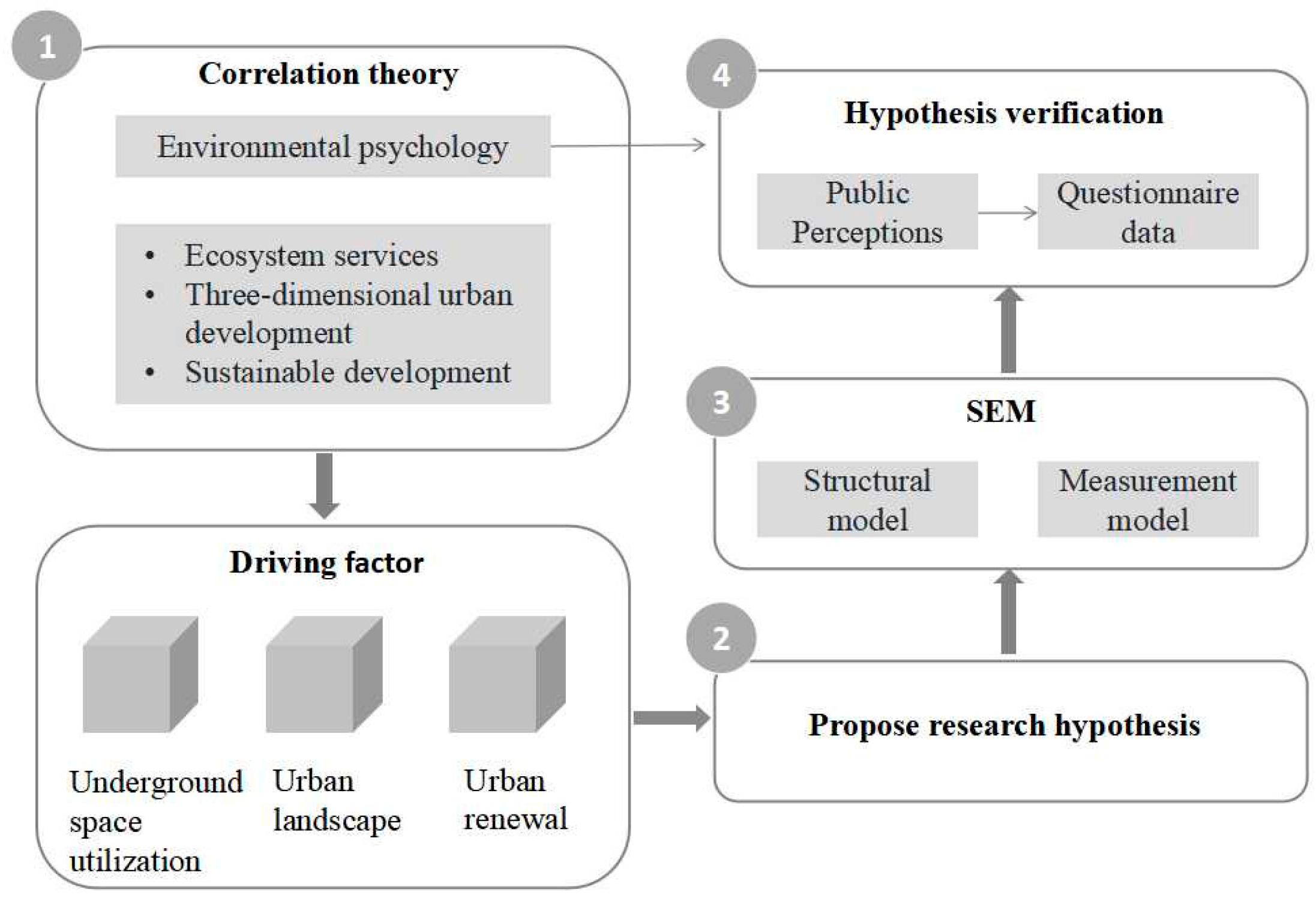
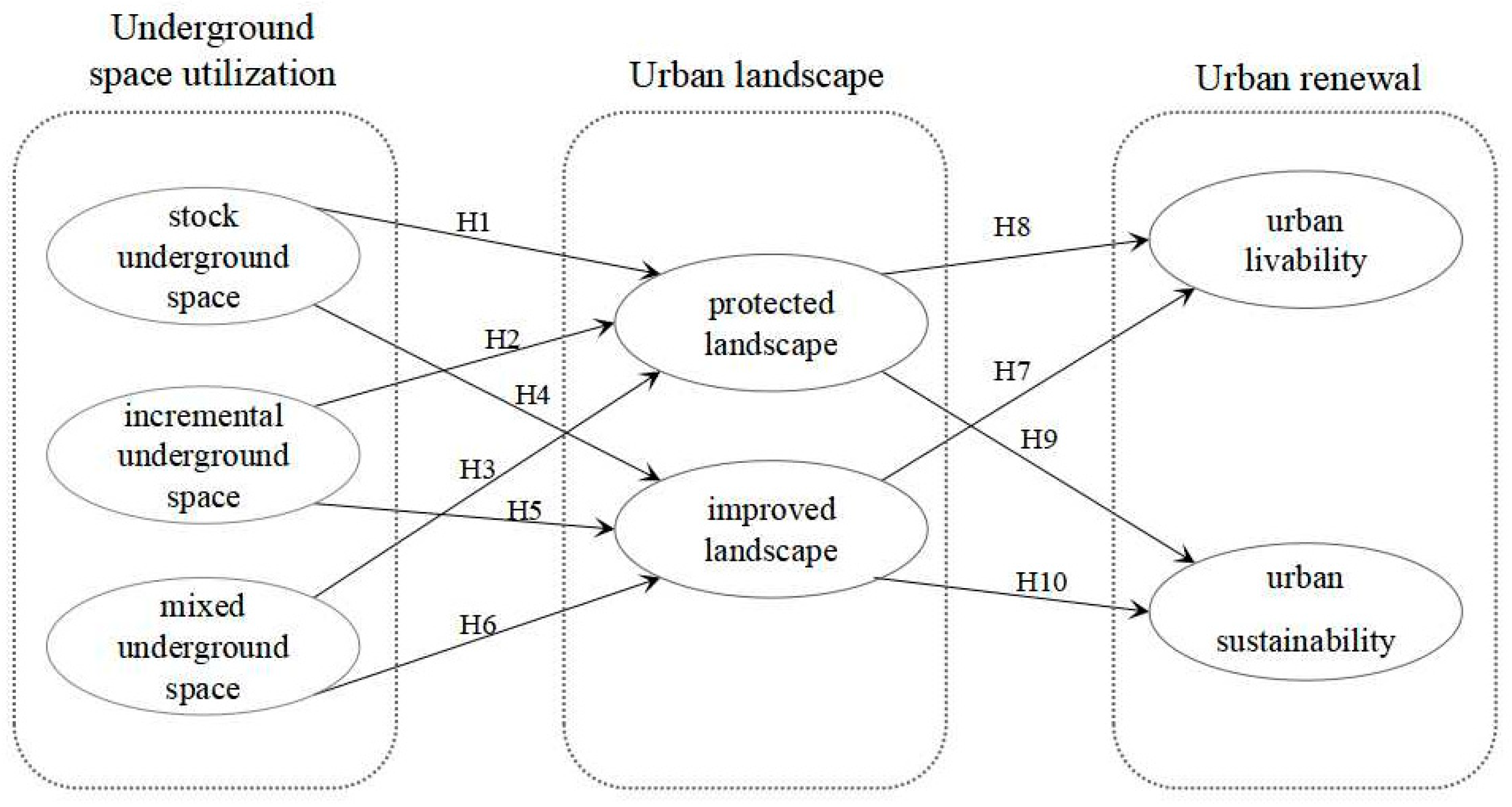
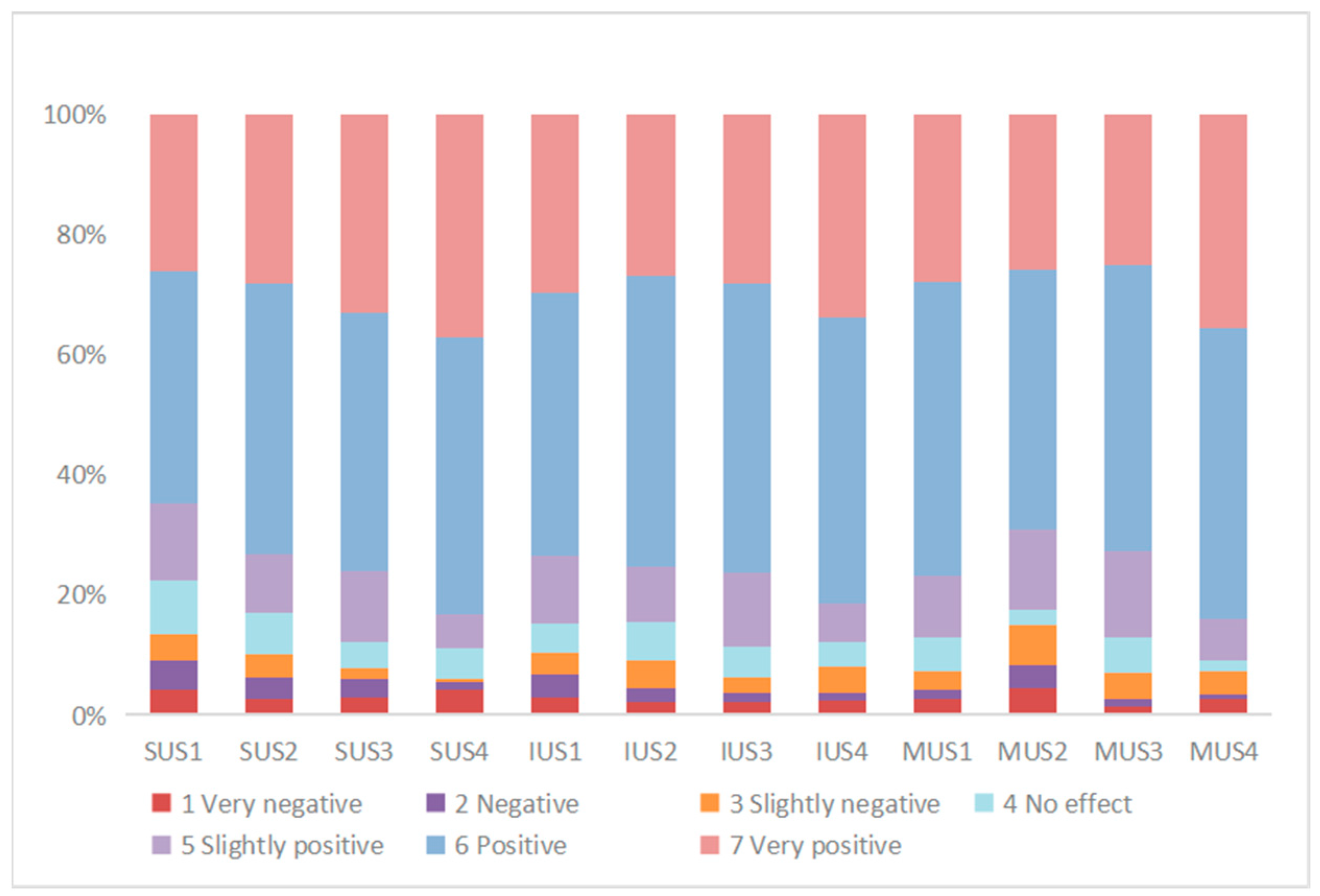

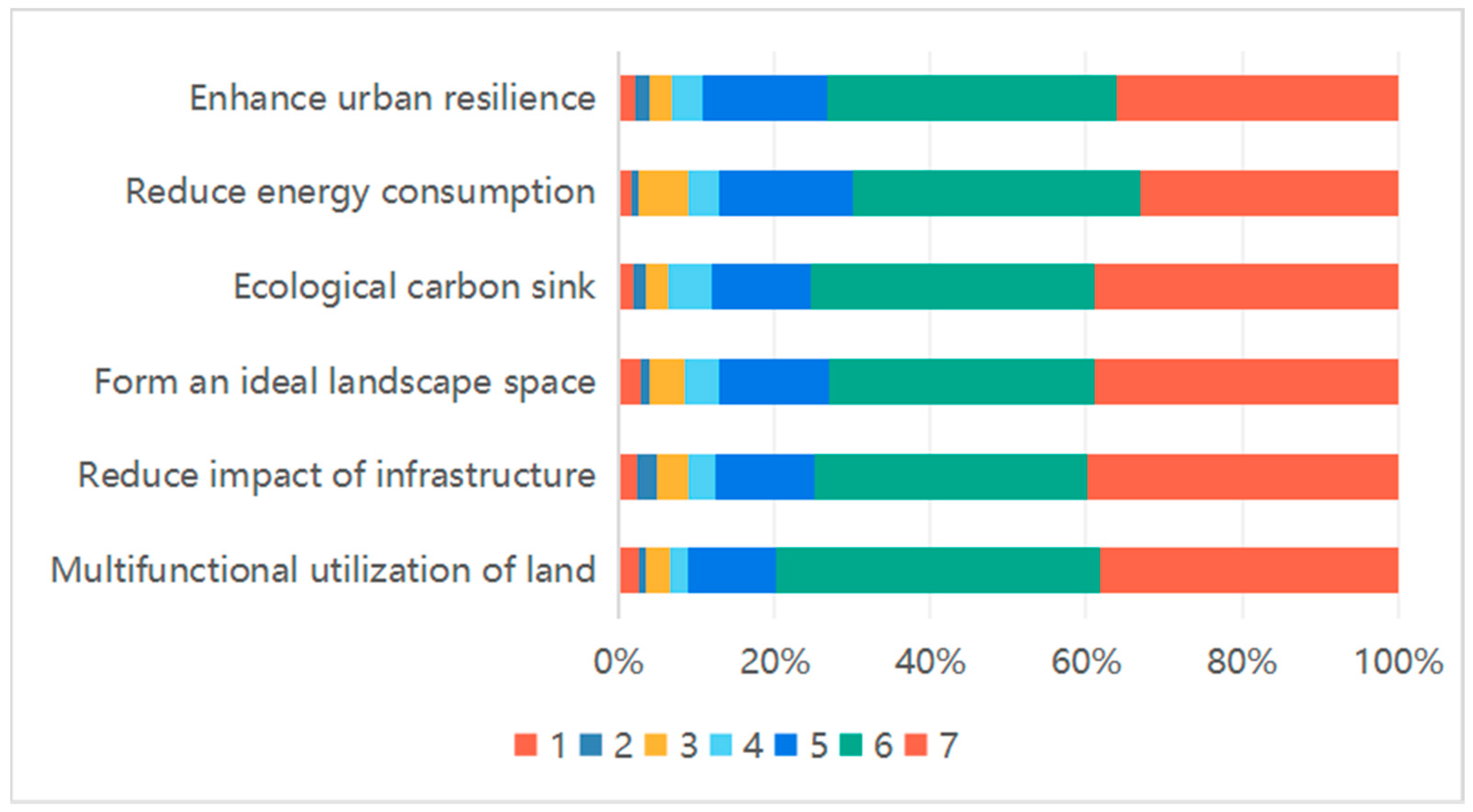
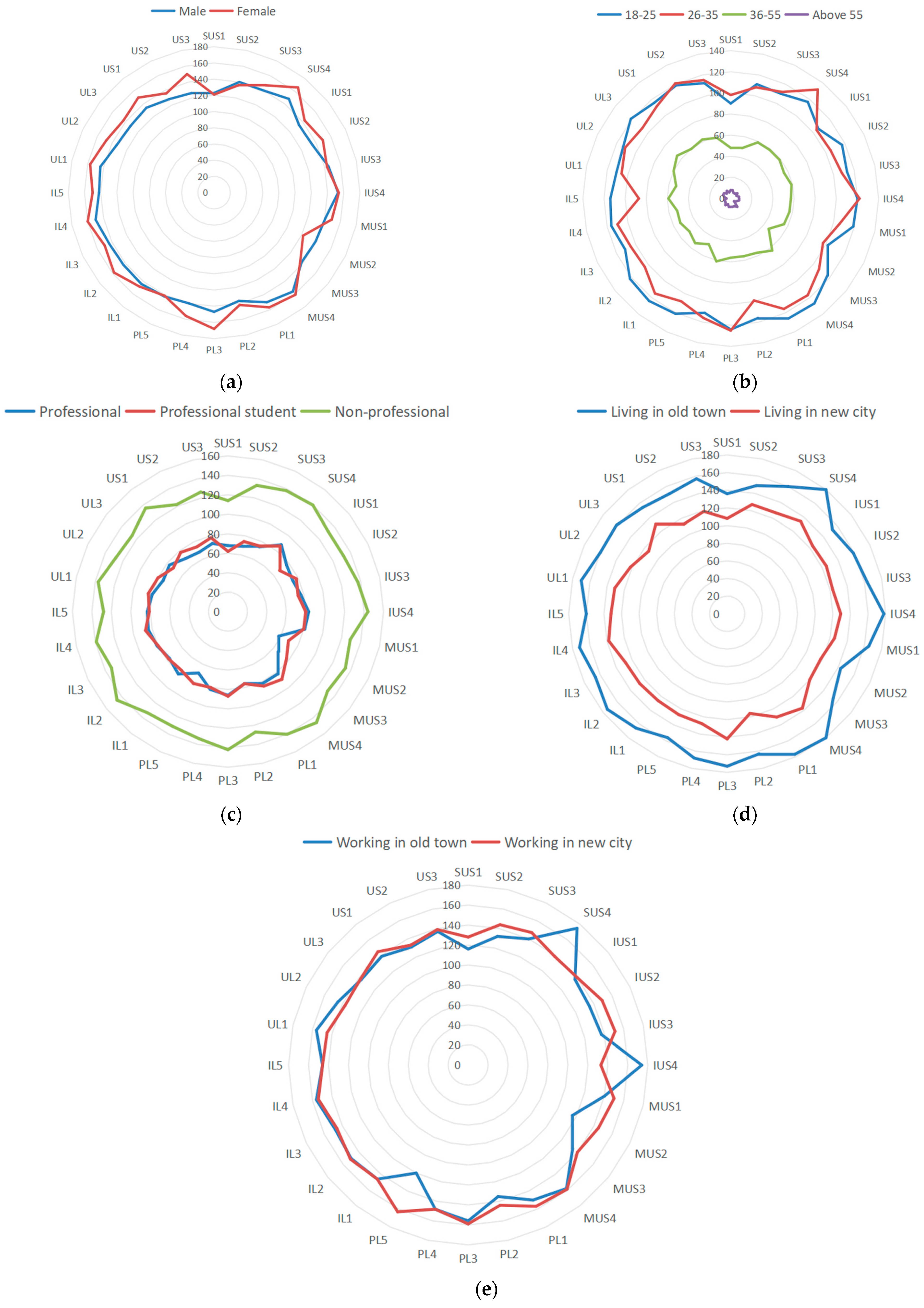
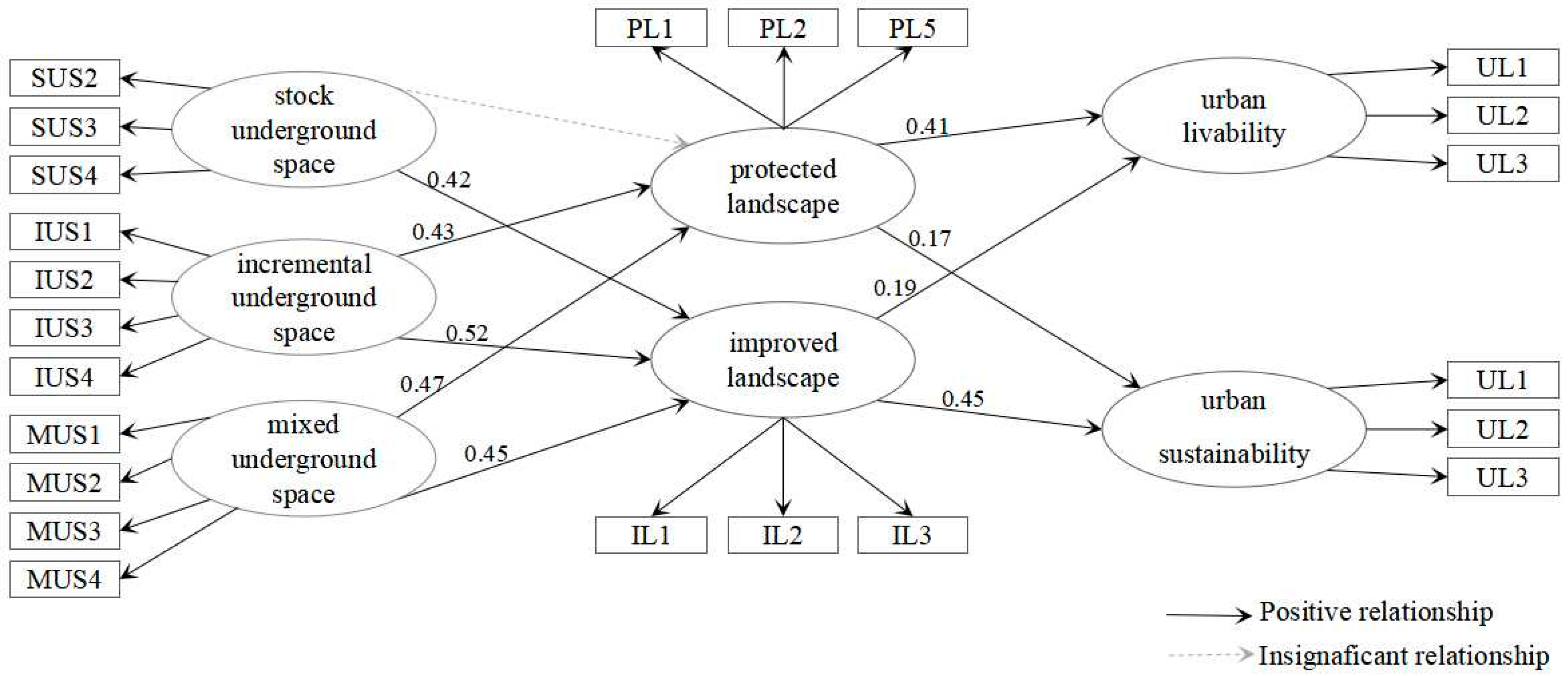
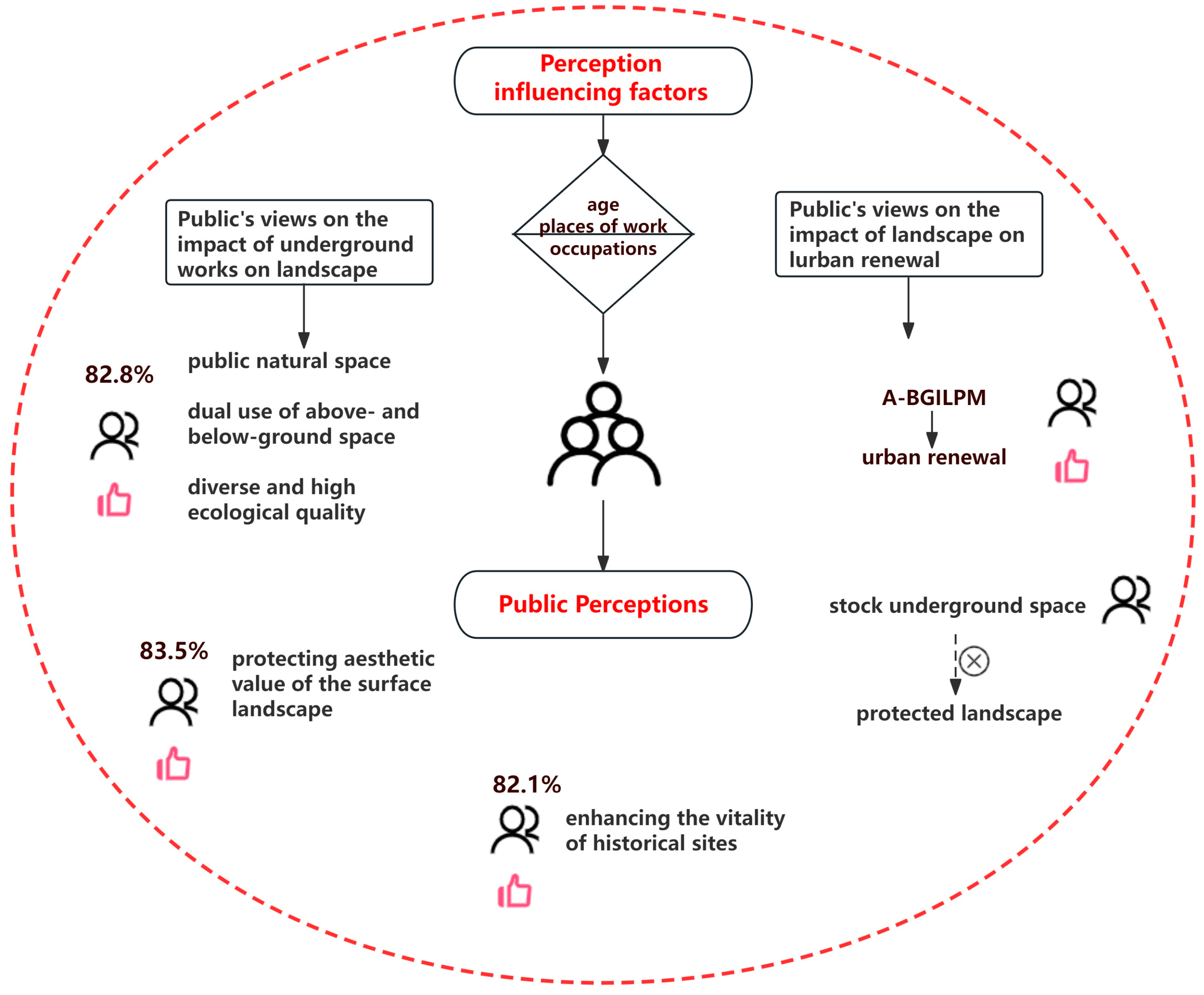
| Construct | Item | Typical Project | Effect |
|---|---|---|---|
| SUS | SUS1 | The abandoned civil air defense transform project under the green belt in Shanghai | Prevention of damage to the green space, the “road zipper” has been closed through transformed comprehensive pipe corridor |
| SUS2 | Underground parking under the green belt | Prevention of ground space occupation, enabling the ground-level green spaces to continue purifying the air and beautifying the environment | |
| SUS3 | InterContinental Shanghai Alice, an ecological hotel constructed by utilizing a deep quarry pit | Ecological restoration of the site, enabling people to enjoy the natural scenery of the cliffs | |
| SUS4 | Cheonggyecheon in South Korea [46], underground culverts restored and transformed into urban streams | Revival of the historical and cultural ambiance of Seoul and reshaping of its urban public open spaces | |
| IUS | IUS1 | Caisson parking garage in the city center | Freeing up ground space for green spaces and plazas by using the corner plots in the city center |
| IUS2 | Underground stratified development in Katri Vala Park [47] | Feature four completely independent underground venues dedicated to various underground facilities keeping the park’s beautiful scenery intact | |
| IUS3 | Underground extension of Adeje Religious Museum of Spain | Expansion to two and a half times its original size, and a permanent stage and event space have been established | |
| IUS4 | “Big Dig” project in Boston, the original ground was excavated to bury an expressway underground | Integration and enhancement with the urban walking systems, creating comfortable and convenient urban walking spaces | |
| MUS | MUS1 | Les Halles, situated in the center of Paris, dismantled its food market to create a leisure pedestrian plaza. | Arrangement of various traffic functions in the underground space beneath the square, construction of a large urban center with interconnected upper and lower levels |
| MUS2 | The Shanghai World Expo Cultural Park [48] | Creation of a scenic landscape with the interior hollowed out to accommodate a design for 1500 parking spaces | |
| MUS3 | Tokyo Station transformation, expanding its underground space | Creation of metropolitan square and a north–south traffic square on the ground | |
| MUS4 | Renovation of Jiaxing Railway Station, the primary traffic and supporting commercial functions were relocated underground | Allowing for the complete release of the ground area, which was then transformed into a public green space, giving it the appearance of a “railway station in the forest” | |
| PL | PL1 | Helsinki underground tunnels | Prevention of the disruption of the existing forest, safeguarding of the natural landscape and vegetation on the surface, and preservation of ecological equilibrium and biodiversity |
| PL2 | Shanghai Jing’an Sculpture Park underground substation | Full preservation of the original urban green space, enabling people to enjoy its ecological benefits | |
| PL3 | REGULAR Yuanye in Chengdu | Creation of a park-like commercial area dividing the above- and below-ground worlds, with the original natural landscape above ground and a fashionable urban cultural landscape below | |
| PL4 | China Imperial Examination Museum, the only underground museum | Preservation of the historical monuments and streets on the surface to help protect the traditional urban structure and cultural landscape | |
| PL5 | Shanghai Yangshupu Power Plant Heritage Park | Utilizing underground space for the renewal of the cities without disrupting the existing natural and cultural landscapes helps preserve the economic value of the landscape | |
| IL | IL1 | Shenzhen Buji underground sewage treatment plant | Freeing up of ground space for the creation of parks and other natural landscapes, providing leisure and entertainment spaces for people to enjoy the beauty of nature and relieve stress |
| IL2 | Bahçeşehir transfer center in Istanbul | Construction of underground parking lots and transformation of vacant ground spaces into parks, increasing the amount of urban greenery | |
| IL3 | Quzhou Sports Park, the largest soil-covering complex in the world | Creation of high-quality public spaces such as parks and squares on the surface | |
| IL4 | Louvre underground space renovation [49] | Creation of new uses for the underground space while safeguarding the rich heritage of the city | |
| IL5 | Longhuahui in Shanghai, underground street in the historic district | Invigoration of the city, drawing of more tourists, boosting of the value of the surrounding land, and significant contribution to the urban economy | |
| UL | UL1 | Integrated landscape planning above ground and below ground can create compact and high-quality public space through multifunctional composite utilization of land resources | |
| UL2 | Transportation and infrastructure (such as sewage treatment plants) are placed underground, and parks are built above ground, which can lessen the impact on nearby residents and the overall environment | ||
| UL3 | Transportation and infrastructure are placed underground, and the ground floor can form an ideal landscape space that is safe, reliable, and accessible | ||
| US | US1 | Develop and utilize underground space, save land resources on the ground, build green ecology such as parks and forests, and realize ecological carbon sink | |
| US2 | The sunken plaza can improve the lighting and ventilation of the underground space environment and reduce energy consumption | ||
| US3 | The large substation under the Jing’an Sculpture Park in Shanghai is safer, more reliable, high-quality, and efficient, and the expanded power supply capacity ensures the stability and safety of urban electricity consumption | ||
| Statistical Variables | Category | Frequency | Percentage |
|---|---|---|---|
| Gender | Male | 176 | 46.6 |
| Female | 201 | 53.4 | |
| Age | 18–25 | 148 | 39.2 |
| 26–35 | 147 | 38.9 | |
| 36–55 | 72 | 19 | |
| Above 55 | 10 | 2.1 | |
| Profession | Planning and design professionals | 99 | 26.8 |
| Student of planning and design | 101 | 27 | |
| Non-planning and design professionals | 177 | 46.9 | |
| Place of residence | Old town | 218 | 57.8 |
| New city region | 159 | 42.2 | |
| Employment region | Old town | 197 | 52.2 |
| New city region | 180 | 47.7 |
| Hypothesis | Hypothesized Path | Estimate | S.E. | C.R. | p | Supported? |
|---|---|---|---|---|---|---|
| H2 | IUS→PL | 0.426 | 0.080 | 5.078 | *** | Yes |
| H3 | MUS→PL | 0.466 | 0.068 | 1.128 | 0.059 | Yes |
| H4 | SUS→IL | 0.421 | 0.052 | 5.595 | *** | Yes |
| H5 | IUS→IL | 0.515 | 0.063 | 4.944 | *** | Yes |
| H6 | MUS→IL | 0.446 | 0.072 | 4.143 | *** | Yes |
| H7 | PL→UL | 0.408 | 0.076 | 0.125 | 0.009 | Yes |
| H8 | PL→US | 0.191 | 0.110 | 2.921 | 0.003 | Yes |
| H9 | IL→UL | 0.171 | 0.072 | 2.783 | 0.005 | Yes |
| H10 | IL→US | 0.450 | 0.117 | 6.164 | *** | Yes |
| Model Fit Indicator | Optimal Standard Value | Calculated Value | Fit Condition |
|---|---|---|---|
| CMIN | — | 889.238 | — |
| DF | — | 266 | — |
| CMIN/DF | <3 | 3.343 | Good |
| RMR | <0.8 | 0.071 | Fine |
| GFI | >0.8 | 0.831 | Fine |
| AGFI | >0.8 | 0.884 | Good |
| NFI | >0.9 | 0.879 | Good |
| IFI | >0.9 | 0.884 | Good |
| TLI | >0.9 | 0.911 | Fine |
| CFI | >0.9 | 0.892 | Good |
| RMSEA | <0.08 | 0.058 | Fine |
Disclaimer/Publisher’s Note: The statements, opinions and data contained in all publications are solely those of the individual author(s) and contributor(s) and not of MDPI and/or the editor(s). MDPI and/or the editor(s) disclaim responsibility for any injury to people or property resulting from any ideas, methods, instructions or products referred to in the content. |
© 2024 by the authors. Licensee MDPI, Basel, Switzerland. This article is an open access article distributed under the terms and conditions of the Creative Commons Attribution (CC BY) license (https://creativecommons.org/licenses/by/4.0/).
Share and Cite
Zhao, X.; Chen, Y.; Wu, Y.; Guo, D.; Chen, Z. Enhancing Urban Landscapes through Underground Space Utilization: Public Perceptions. Sustainability 2024, 16, 4501. https://doi.org/10.3390/su16114501
Zhao X, Chen Y, Wu Y, Guo D, Chen Z. Enhancing Urban Landscapes through Underground Space Utilization: Public Perceptions. Sustainability. 2024; 16(11):4501. https://doi.org/10.3390/su16114501
Chicago/Turabian StyleZhao, Xingxing, Yulu Chen, Yanhua Wu, Dongjun Guo, and Zhilong Chen. 2024. "Enhancing Urban Landscapes through Underground Space Utilization: Public Perceptions" Sustainability 16, no. 11: 4501. https://doi.org/10.3390/su16114501
APA StyleZhao, X., Chen, Y., Wu, Y., Guo, D., & Chen, Z. (2024). Enhancing Urban Landscapes through Underground Space Utilization: Public Perceptions. Sustainability, 16(11), 4501. https://doi.org/10.3390/su16114501







